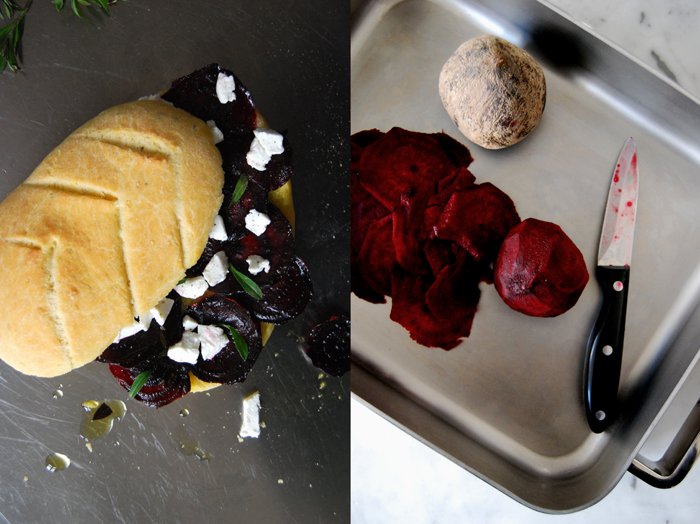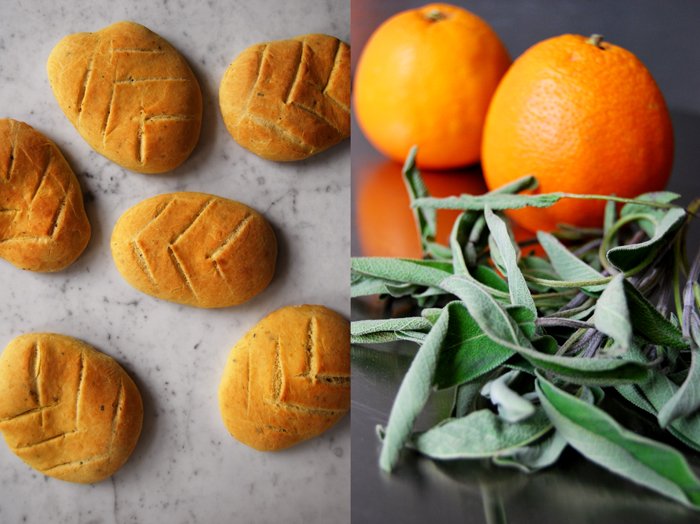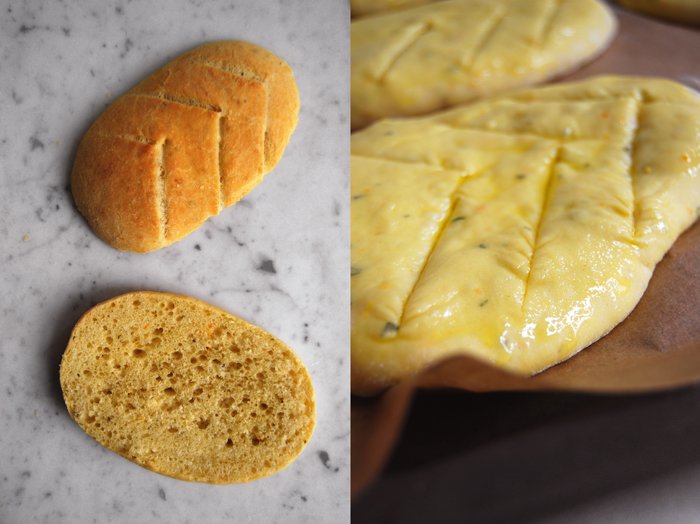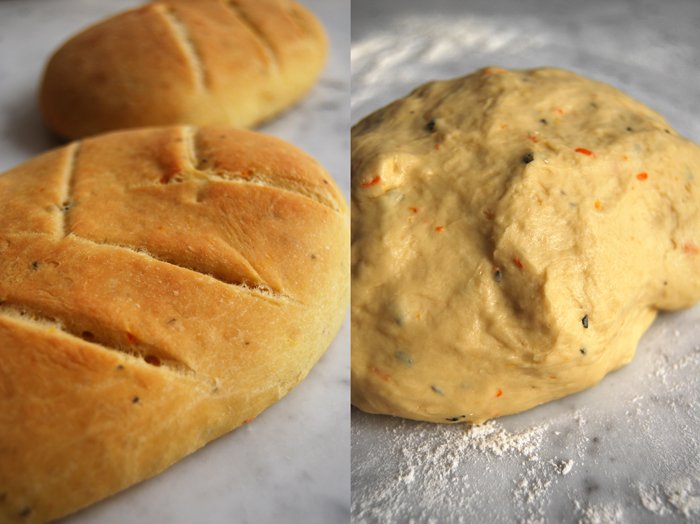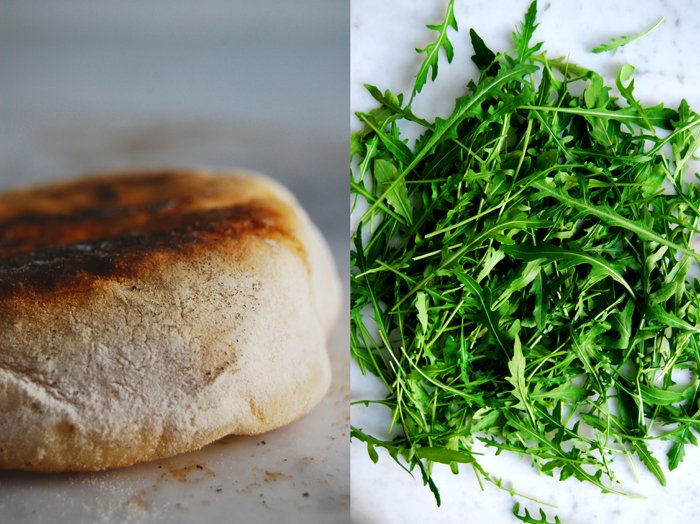Fougasse Sandwich with Baked Beetroot, Goat Cheese and Thyme
I got really hooked on the roots and syrup combination in the past week. It all started with my ginger honey glazed Navet, yellow turnip fried as vegetarian steaks followed by caramelised maple parsnip with goat cheese combined in a warm salad and I'm still in the mood for sweet and earthy duos, at least one more.
It's Sandwich Wednesday and the first thing that came into my mind when I looked at the beautiful Fougasse bread I baked yesterday, was a baked beetroot sandwich. My flatbread has strong aromas of orange and sage, perfect to add some more earthy and sweet flavours. There are some beetroots lying on my kitchen window sill, just waiting to be baked in maple syrup and olive oil sprinkled with thyme. I found a kind of thyme at the organic store that I have never seen before, with thick, long leaves. They are stronger in taste compared to the small leaved one, a bit woody. The thin slices of the roots are done after 10 minutes in the oven, soft, syrupy and partly crisp. I let them soak into the oily bread and finish my sandwich with some mild goat cheese crumbled on top to add some fresh milkiness.
I made 3 flatbread sandwiches with 3 small beetroots peeled and cut into very thin slices and mixed with 3 tablespoons of olive oil and 2 tablespoons of maple syrup. I seasoned the roots with salt and pepper, mixed them with a few sprigs of thyme and roasted them spread in a roasting tin for 12 minutes in the hot oven set to 220°C / 430°F (Rotitherm roasting setting) until they were soft.
If you don't want to make your own Orange Sage Fougasse bread (I can just recommend it as it's fantastic), you can also use focaccia or soft buns (I made some very soft and juicy Mountain Buns with spices a couple months ago). I cut the flatbread in half, drizzled some olive oil (generously) on one side and spread the roast beetroot slices on top. After I sprinkled them with goat cheese (for 3 sandwiches I used 100g / 3.5 ounces of cheese), some fresh thyme leaves, salt and pepper, I closed my Fougasse sandwich, pleased about another great sweet root variation!
Fougasse Bread with Orange, Sage and Olive Oil
It's time to bake bread again! I use a recipe which involves sage and my beloved blood oranges, they'll be out of season soon, so I'm using every possible occasion that allows me to cook or bake with my sweet citrus fruits. I mix generous amounts of their zest and juice into the dough and the result is impressive!
My bread is a light and aromatic Fougasse, a French flatbread very popular in Provence where it's often made with olives, herbs and cheese. It's similar to the Italian Focaccia but with a leaf pattern of cuts in the dough. In some recipes, the cut goes all the way through creating holes in the bread while it's baking which makes the bread harder. I prefer to leave mine juicy with shallow cuts on the surface. Besides the orange and sage I add good olive oil in and on the bread. I use the wonderful extra virgin olive oil from the Molise region which I got from Marilena. Its strong and fruity taste is just what my Mediterranean flatbread needs!
I already have a great idea for a sandwich I can make with this bread for tomorrow's Sandwich Wednesday!
Fougasse with Orange, Sage and Olive Oil
For 6 flatbreads you need
plain flour 400g / 14 ounces (I use spelt flour type 630 but you can use any other plain flour)
dry yeast 1 package (for 500g / 1 pound flour)
salt 1 teaspoon
fresh sage, chopped, 8-10 leaves
zest of 1 medium sized orange
freshly squeezed blood orange or orange juice 100ml
water, lukewarm, 100ml
olive oil 5 tablespoons plus more for brushing the bread
organic egg 1
Combine the flour, yeast, salt, orange zest and sage in a large bowl. Add the water, orange juice and egg and mix with your dough hooks for 5 minutes. On a floured surface, continue kneading with your hands for a few minutes until you have an elastic dough ball. Put the dough back into the bowl and cover with a tea towel. Let the dough rise in a 35°C / 95°F warm oven for 45 minutes. This works really well but make sure that your oven is set to top/ bottom heat and not to fan.
Take the dough out and punch it down. Divide it into 6 pieces and roll them out into egg shaped discs (on a floured working surface, around 1 1/2 cm / 1/2″ thick). Put them on a baking sheet lined with parchment paper, cover with a tea towel and let them rise for 20 minutes.
Set your oven to 210°C / 410°F.
Brush the flatbread with olive oil and cut a pattern of 6-8 diagonal slashes into the dough to make a leaf pattern. Bake the flatbread on the lowest level for 12-15 minutes or until golden brown. Take them out and let them cool for 2 minutes.
I cut the warm flatbread in half and drizzled some more olive oil over it, it merged perfectly with the orange and sage aromas!
A Ladin Sandwich with Spices and Tyrolean Prosciutto
I used to eat this sandwich whenever I arrived in Corvara, I went straight to the bakery to get some local flatbread and then to the butcher for prosciutto. Outside the shop, I prepared my sandwich, sat on a bench in the snow and enjoyed the start of my holiday.
Last week I read about this bread, the bread of my mountain village of choice. It is a flatbread made with rye flour mixed with coriander, fennel and aniseed. It's a speciality in the Ladinia region around the Sella mountains in the Italian Dolomite Alps. In Italian this area is called Val Badia and the Ladin name (which is an autonomous language) is Alta Badia.
There are two ways to prepare this bread, one is more flat, it becomes dry, hard and brittle after baking. It's very thin and you "shake" the dough to loosen it up which gives it its name, "Schuettelbrot" (shaken bread). This method was used to preserve the bread for the long and lonely time in the mountain huts where the supply of fresh bread and food was an unfrequent and laborious task. It keeps for months, the texture is hard but it retains its strong taste of spices.
The second one is thicker and this is the one I choose to make, at it's best when fresh and warm. Although it's not as light and fluffy as a flatbread made with wheat flour, it's denser and more complex in taste. Traditionally you eat this bread together with Tyrolean Prosciutto at Vesper time, in the afternoon or evening when you feel like a little snack. My mother sent me a nice piece of prosciutto from San Cassiano, so I use this special occasion for this week's Sandwich Wednesday.
A Ladin Sandwich with Spice Flatbread and Tyrolean Prosciutto
I spread some cream cheese on the flatbread, traditionally it's made without, but I was in the mood for it.
For 8 little flatbreads you need
rye flour 180g / 6.5 ounces
spelt flour 180g / 6.5 ounces
dry yeast 1 package (for 500g / 1 pound of flour)
water, lukewarm, 125ml
milk, lukewarm, 50ml
coriander seeds, ground, 1 teaspoon
fennel seeds, ground, 1/2 teaspoon
aniseed, ground, 1/2 teaspoon
caraway seeds, ground, 1/4 teaspoon
salt 1/2 teaspoon
olive oil to grease the baking sheet
For the sandwich
Tyrolean Prosciutto 3 slices for each flatbread
cream cheese (optional)
crushed black pepper
Combine the flour with the spices, yeast and salt, add the lukewarm water and the milk, slowly, not all at once (you might not need all of it). Mix with your dough hooks for a few minutes. The dough should be more on the dry side. Continue kneading and punching with your hands until you have an elastic dough ball, not sticky at all. Put the dough back into the bowl, cover with a tea towel and let it rise in the warm oven (35°C / 95°F) for 45 minutes. This works really well but make sure that your oven is set to top/ bottom heat and not to fan.
Take the dough out and punch it down. Divide it into 8 pieces and roll them out into discs (on a floured working surface, between 1 - 1 1/2 cm / around 1/2" thick). Cover with a tea towel and let them rise for another 25 minutes.
Set your oven to 250°C / 480°F. My oven has a special pizza setting which I use for this recipe but you can use top / bottom heat as well. Grease your baking sheet with some olive oil.
Put your flatbreads on the baking sheet and bake them on the lowest level for 10 minutes or until golden brown. Take them out and let them cool for 2 minutes. Cut a bread in half, spread with cream cheese and cover with a few slices of the prosciutto. You can sprinkle some crushed black pepper over it too.
Umbrian Torta al Testo with Rucola and Mozzarella
This week's sandwich is my version of Torta al Testo - the Umbrian flatbread - stuffed with rucola and mozzarella together with a dressing of olive oil and balsamico. Originally, this bread is unleavened, just made with flour, salt and water. I add some dry yeast, some use baking soda or sourdough. The name Torta al Testo comes from the fact that, traditionally, it is cooked on a hot disc of clay or metal - al testo - over the open fire, as I don't have that I use a skillet on a normal cooker.
Torta al Testo has everything a good sandwich needs: amazing bread and a tasty filling. What I also like about it, is the way it's cooked. It's fun to see the flat disc of dough rising and cooking in the hot pan within a couple minutes. It's very entertaining! I recently had friends over for dinner and Torta al Testo was the starter. We gathered in the kitchen, crowded as always, I cooked the bread and we all watched it rise. The kitchen was packed with people and food, I cooked one batch of flatbread after the other (I had to make quite a few of them) and the room got more and more smokey from the hot pan. Thankfully no one left, even though you could barely see anymore after I had left one in too long. We were all kind of mesmerized by the rising bread but don't worry, if you watch your bread it will be fine, no need for a fire alarm!
Torta al Testo with Rucola and Mozzarella
For 6 Torta al Testo you need
For the dough
plain flour 250g / 9 ounces plus more for mixing (I use spelt flour type 630 but you can use any other flour)
dry yeast 1 1/2 teaspoons
water, lukewarm, 140ml
salt 1/4 teaspoon
For the filling
mozzarella, cut into cubes, 125g / 4.5 ounces
rucola around 100g / 3.5 ounces
olive oil (6 tablespoons) mixed with balsamic vinegar (3 tablespoons) and seasoned with salt and pepper
Mix all the ingredients for the dough with the hooks of your mixer. Add some more flour if the mixture is too sticky. After 5 minutes continue mixing with your hands for a couple minutes. Put the dough back into the bowl, cover it with a tea towel and let it rise in a warm place or the warm oven (35°C / 95°F, top/ bottom heat, no fan) for 40 minutes.
Divide the dough into 6 pieces. On a well floured working surface, roll each one out into a flat disc. Leave the discs on the floured surface, cover with a tea towel and let them rise for another 20 minutes.
Heat a large skillet on highest temperature (no oil!). Cook the bread on one side for 1 - 1 1/2 minutes, turn and cook on the other side for another minute, at that point it will start to rise rapidly. You might have to cook it for a few seconds more or less - but keep an eye on it so as not to burn it.
Take the bread out of the pan and let it cool for a minute. Cut your flatbread in half and fill with the mozzarella and rucola. Drizzle some dressing on top and close your Torta al Testo.





